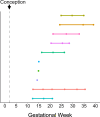Longitudinal investigation of neurobiological changes across pregnancy
- PMID: 39827275
- PMCID: PMC11743213
- DOI: 10.1038/s42003-024-07414-9
Longitudinal investigation of neurobiological changes across pregnancy
Abstract
Pregnancy is a period of profound biological transformation. However, we know remarkably little about pregnancy-related brain changes. To address this gap, we chart longitudinal changes in brain structure during pregnancy and explore potential mechanisms driving these changes. Ten participants (Mean age = 28.97 years) are assessed 1-6 times (median = 3) during their pregnancy. Each visit includes anatomical and diffusion-weighted MRI, and assessments of waking salivary hormones, hair hormones, and inflammatory cytokines. Here we observe a reduction in gray matter volume and an increase in neurite density index (NDI), a proxy of axon density, in white matter tracts across pregnancy. Progesterone levels are associated with reductions in brain volumetric measurements, and both progesterone and estradiol levels are linked to increases in NDI in white matter tracts. This study highlights the profound neurobiological changes experienced by pregnant individuals and provides insights into neuroplasticity in adulthood.
© 2025. The Author(s).
Conflict of interest statement
Competing interests: The authors declare no competing interests.
Figures







Update of
-
Longitudinal Investigation of Neurobiological Changes Across Pregnancy.bioRxiv [Preprint]. 2024 Dec 17:2024.03.08.584178. doi: 10.1101/2024.03.08.584178. bioRxiv. 2024. Update in: Commun Biol. 2025 Jan 18;8(1):82. doi: 10.1038/s42003-024-07414-9. PMID: 39763749 Free PMC article. Updated. Preprint.
References
-
- Tan, E. K. & Tan, E. L. Alterations in physiology and anatomy during pregnancy. Best Pract. Res. Clin. Obstet. Gynaecol.27, 791–802 (2013). - PubMed
-
- Martínez-García, M., Cardenas, S. I., Pawluski, J., Carmona, S. & Saxbe, D. E. Recent neuroscience advances in human parenting. Patterns Parent. Behav. Anim. Sci. Comp. Ethol. Neurosci239, 267 (2022). - PubMed
MeSH terms
Substances
Grants and funding
LinkOut - more resources
Full Text Sources
Miscellaneous

